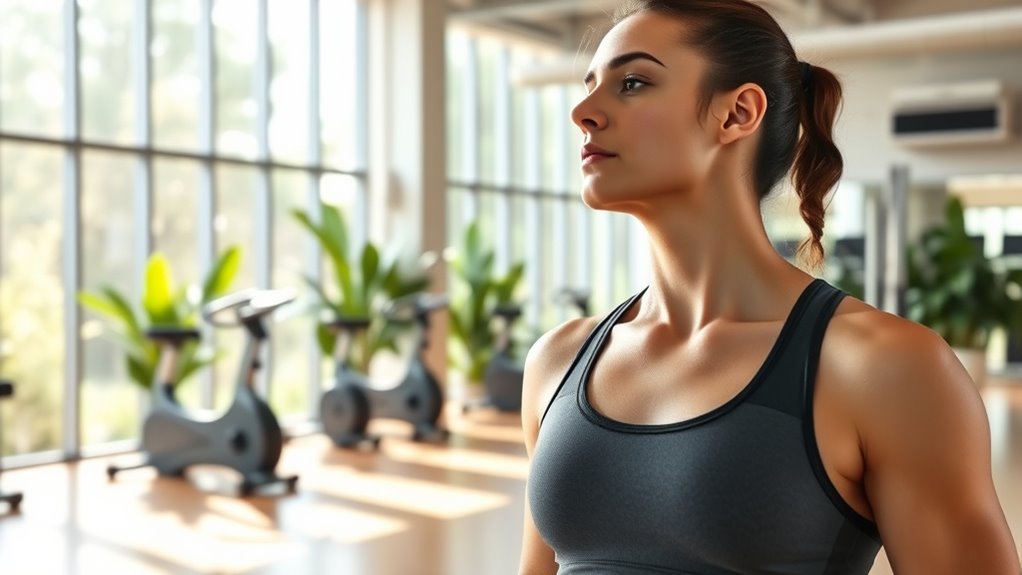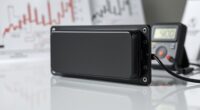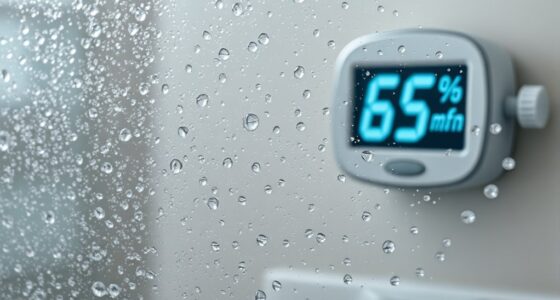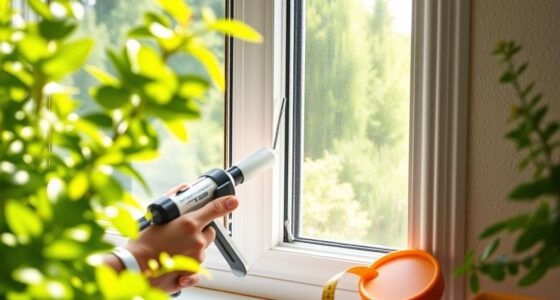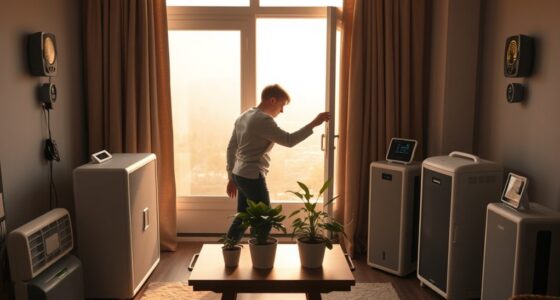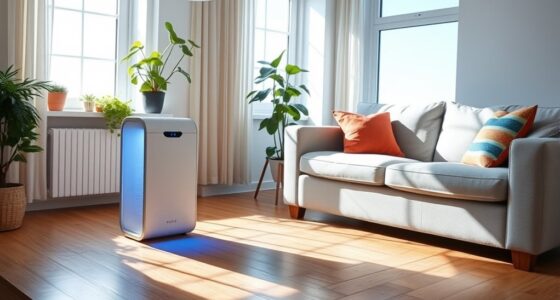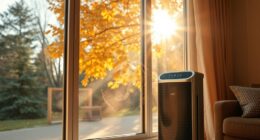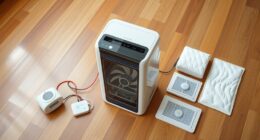To optimize indoor training spaces, focus on improving air quality by controlling dust, mold, and chemicals through regular cleaning and humidity management. Use air purifiers with HEPA filters to remove airborne pollutants, ensuring better breathing and stamina during workouts. Choosing low-emission equipment also helps create a healthier environment. Maintaining excellent air quality supports your performance, recovery, and long-term health—discover more ways to keep your indoor space at its best.
Key Takeaways
- Regularly clean indoor spaces to reduce dust, mold, and chemical pollutants affecting breathing and performance.
- Control humidity levels to prevent mold growth and maintain optimal indoor air quality.
- Use HEPA air purifiers to remove airborne particles, allergens, and pathogens, supporting healthier lungs.
- Choose low-emission equipment and cleaning products to minimize VOCs and chemical pollutants.
- Monitor and improve ventilation to ensure fresh air circulation and reduce indoor pollutant concentration.
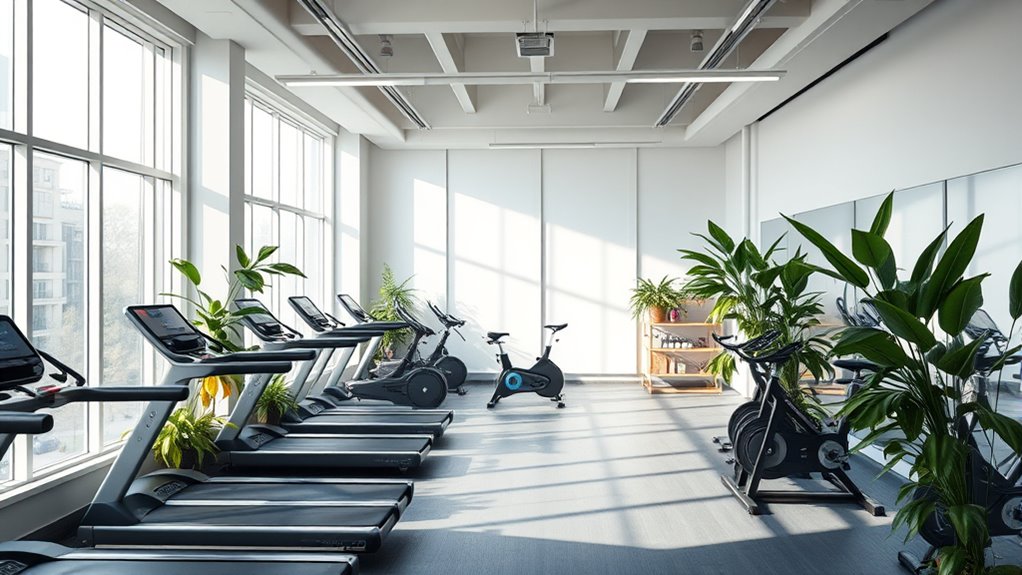
Have you ever wondered how air quality impacts your performance as an athlete? The truth is, it plays a vital role in how well you train, recover, and ultimately reach your goals. One of the key factors in maintaining ideal indoor training spaces is effective pollution control. Indoor air often accumulates pollutants from various sources, including dust, mold, cleaning chemicals, and even indoor equipment. If these pollutants are left unchecked, they can lead to respiratory issues, fatigue, and decreased stamina, undermining your efforts. Consequently, implementing pollution control measures is essential. This involves regular cleaning, controlling humidity levels to prevent mold growth, and choosing low-emission equipment and materials. By reducing airborne contaminants, you create a healthier environment that supports better breathing and enhances your overall athletic performance. Additionally, selecting Air Purification Technologies such as HEPA filters can significantly improve air quality by trapping fine particles and pathogens. Air purification is another vital element in maintaining indoor air quality. Not all pollutants are visible, and some can linger in the air for extended periods, silently affecting your health. High-efficiency air purifiers equipped with HEPA filters can trap fine particles like dust, pollen, pet dander, and even some bacteria and viruses. These devices greatly improve air clarity, allowing you to breathe easier during intense workouts. When selecting an air purifier, consider the size of your training space and the purifier’s capacity to guarantee effective coverage. Proper air purification not only reduces immediate respiratory discomfort but also minimizes long-term health risks associated with poor indoor air quality. It’s a proactive approach that keeps your lungs healthier and your energy levels higher throughout your training sessions.
Frequently Asked Questions
How Does Indoor Air Quality Affect Athletic Performance?
Indoor air quality directly impacts your athletic performance by influencing your respiratory health. When air pollution levels are high indoors, you may experience reduced lung function and fatigue, which can hinder your stamina and recovery. Poor air quality leads to respiratory issues, making it harder to breathe deeply and perform at your best. To stay at peak performance, guarantee your training spaces are well-ventilated and free from pollutants.
What Are the Best Air Purifiers for Indoor Gyms?
When choosing the best air purifier for indoor gyms, focus on models with advanced cleaning technology like HEPA filters, activated carbon, and UV sterilization. Look for features such as high CADR ratings for efficient air exchange, easy maintenance, and quiet operation. These features guarantee contaminants are effectively removed, creating a healthier environment. Investing in a purifier with these qualities helps improve air quality, boosting both safety and athletic performance indoors.
How Often Should Indoor Training Spaces Be Ventilated?
Your indoor training space is a powerhouse of activity, so you need to keep it fresh. You should aim for an air exchange every 30 minutes, especially during intense workouts. Establish a consistent ventilation schedule, opening windows or using HVAC systems to guarantee a steady flow of fresh air. Regular ventilation reduces indoor pollutants and keeps your space safe and energizing, helping you perform at your best every session.
Can Indoor Plants Improve Air Quality for Athletes?
Indoor plants can improve air quality by providing natural air filtration, which benefits athletes during training. Their ability to absorb pollutants and release oxygen creates a healthier environment. You’ll notice better airflow, reduced indoor pollutants, and a more invigorating space. Incorporating indoor plant benefits into your training area not only enhances aesthetics but also promotes cleaner, more breathable air, helping athletes perform at their best with improved indoor air quality.
What Are Common Indoor Air Pollutants Harmful to Athletes?
You should be aware that common indoor air pollutants like indoor VOCs and particulate matter can harm your health and performance. VOCs come from paints, cleaning products, and furnishings, while particulate matter includes dust, pollen, and smoke. These pollutants can cause respiratory issues, reduce lung function, and increase fatigue. To stay healthy and perform your best, guarantee proper ventilation, use air purifiers, and minimize sources of indoor VOCs and particulate matter.
Conclusion
Ensuring good air quality in your indoor training space isn’t just a nice-to-have—it’s a must for peak performance. When you prioritize fresh air, you set the stage for success and avoid the pitfalls of breathing in trouble. Think of it as giving yourself a leg up; clear, clean air fuels your body and sharpens your mind. Keep your space well-ventilated, and you’ll be ready to face any challenge head-on, with nothing holding you back.
